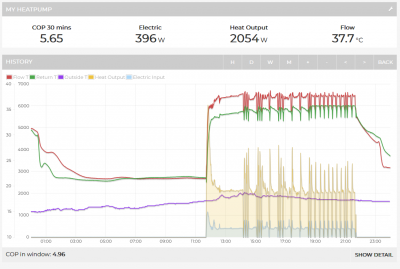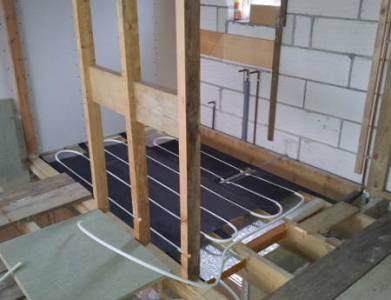New build, ASHP & UFH - advice please
Hi,
I’ve done a lot of reading on this and other websites but can’t quite work out an answer to my new set up. I was hoping to get some help, advice and opinion on my questions if that’s at all possible please.
we are buying a new build home which has the following set up:
- a Daikin ASHP
- underfloor heating throughout the downstairs with each room on a zone, and a thermostat on the wall in each room
- Daikin unvented cylinder
- radiators upstairs on one zone, but only one thermostat in the master bedroom
- electric towel rails in bathrooms and en suites
I’ve seen lots of articles relating to zoning and why it might not be a good idea, but each room downstairs is zoned and the upstairs is on a zone. Is this likely to be less efficient?
Is it worthwhile/sensible to put a digital TRV on each radiator upstairs to be able to control each bedroom individually? For example we may want the nursery warmer than the master bedroom…I know you can do this with manual TRVs but it’s a bit trial and error.
I’ve read that cycling is bad for an ASHP, so do people leave it running 24/7 all year round? Do you turn it off in the summer like you would with a gas boiler?
Can anyone think of anything else I may have missed or need to look out for?
cheers
Richard
Since noone has yet replied, Ill try and add my understanding of the situation. Zoning heat pumps is generally thought to be a mistake as it may cause the system to require higher flow temperautures and thus lower its effiency even though you are heating a bigger volume. I think this probably comes with caveats such as how good the insulation between rooms is. You can certainly play around with keeping zones on permanently.
Generally TRVs are also frowned upon for the above reason and also that they alter the flow volume available to the system, that said I have them and I know others do too.
Cycling reduces the heat pumps efficiency, but it is also normal for the system to periodically switch off (see my system below which has a good COP), however very rapid switching on and off is to be avoided.
Others may disagree with what I have suggested, but its the start of an answer for you.
House-2 bed partial stone bungalow, 5kW Samsung Gen 6 ASHP (Self install)
6.9 kWp of PV
5kWh DC coupled battery
Blog: https://thegreeningofrosecottage.weebly.com/
Heatpump Stats: http://heatpumpmonitor.org/system/view?id=60
Posted by: @sickyHi,
I’ve done a lot of reading on this and other websites but can’t quite work out an answer to my new set up. I was hoping to get some help, advice and opinion on my questions if that’s at all possible please.
we are buying a new build home which has the following set up:
- a Daikin ASHP
- underfloor heating throughout the downstairs with each room on a zone, and a thermostat on the wall in each room
- Daikin unvented cylinder
- radiators upstairs on one zone, but only one thermostat in the master bedroom
- electric towel rails in bathrooms and en suites
I’ve seen lots of articles relating to zoning and why it might not be a good idea, but each room downstairs is zoned and the upstairs is on a zone. Is this likely to be less efficient?
Is it worthwhile/sensible to put a digital TRV on each radiator upstairs to be able to control each bedroom individually? For example we may want the nursery warmer than the master bedroom…I know you can do this with manual TRVs but it’s a bit trial and error.
I’ve read that cycling is bad for an ASHP, so do people leave it running 24/7 all year round? Do you turn it off in the summer like you would with a gas boiler?
Can anyone think of anything else I may have missed or need to look out for?
cheers
Richard
Hi Richard, welcome to the forum.
Having zones with individual room controls may seem desirable and may possibly be a good idea with a gas or oil boiler, but it is unlikely to work efficiently with a heat pump system.
Heat pumps work more efficiently when the temperature of the water coming out, the Leaving Water Temperature (LWT), is as low as possible. Heat emitters (UFH and/or radiators) transfer thermal energy more effectively when the LWT is higher, so the two requirements are at odds with one another.
To try to achieve a reasonable balance between the two, it is often necessary for the installation of larger heat emitters in a heat pump system, which allows for adequate thermal energy transfer to take place whilst operating at a lower LWT.
With a zoned system you are effectively varying the size of the heat emitter capacity, from the smallest system being in operation to the full system being in operation. It is only when the full capacity of the heat emitters is being utilised, that the LWT can be kept at a minimum.
For optimum efficiency of your heat pump system, you should therefore consider operating with all the room thermostats set at a temperature of 1C higher than the desired room temperature, then balance the flow through each UFH loop and each radiator to achieve the desired room temperature. The heat pump should also be set to operate in Weather Compensation (WC) mode, so that it varies the produced LWT to match the heat demand of your home.
Interesting proposals @sicky
I'm wondering why you think you'll need upstairs radiators in addition to ground-level UHF in a new-build house.
Since we normally want to have lower bedroom temperatures, and new-builds should benefit from good insulation, then why isn't it adequate to allow the heat to rise from below?
Is yours an 'upside down' house, perhaps?
There is a case for wanting heating within an upstairs bathroom (& en-suite), however.
When adding an en-suite within an extension, I placed UFH pipes beneath the floor and through a 'towel' radiator.
To maximise the radiating heat-surface area, I not only had UFH loops below the tiled floor, but also beneath a ceramic walk-in shower tray 🙂
The warm floor surface works well.
But it obviously takes longer to dry towels when the water temperature is below 45°C
The two solutions I've used are:
- allow extra space to hang towels so that they aren't folded across the heated rail
- ensure that there's adequate ventilation to remove the humid air (I have a whole-house MVHR system, which does the job)
Save energy... recycle electrons!
-
Ecodan Pump Issues… Circulation pump turns off when heat pump compressor turns off
4 hours ago
-
Running my new Nibe ASHP efficiently
2 days ago
-
Weather compensation- why you should use it
1 week ago
-
Rodents! A word of warning for heat pump owners
1 week ago
-
Where has Watson gone?
1 week ago
- 26 Forums
- 2,418 Topics
- 54.8 K Posts
- 400 Online
- 6,098 Members
Join Us!
Worth Watching
Latest Posts
-

RE: Water outage in the the south-east
Item 3 😀 😀 As do I, as a backup to ...
By Abernyte , 1 minute ago
-

RE: Is my Samsung gen6 outside air temp sensor missing a sheath/sleeve?
@papahuhu OK, filled cavity and 300mm insulation would ...
By bontwoody , 7 minutes ago
-
RE: Reliable, easy to use home battery options
I can confirm that not only does it work without intern...
By Batpred , 1 hour ago
-
Are split ASHPs with R290 refrigerant coming soon?
Question. Are there any (or likely to be in the near t...
By iotum , 1 hour ago
-
RE: Solis inverters S6-EH1P: pros and cons and battery options
Actually I am now finding that the return can be signif...
By Batpred , 1 hour ago
-

RE: Setback savings - fact or fiction?
Indeed. In many ways, a defrost is a setback, with the ...
By cathodeRay , 1 hour ago
-
RE: Heat pump not reaching flow temperature
The good news is that it leaves no excuse if it doesn't...
By JamesPa , 2 hours ago
-
RE: How to use my Hanchu battery storage for home without it feeding back into the grid?
@countryman-helmsley In that case is there a button ...
By IRMartini , 2 hours ago
-
RE: Recommended home battery inverters + regulatory matters - help requested
Thanks. Thats pretty much my intended route i...
By JamesPa , 3 hours ago
-
RE: Is it normal to use power from the grid when running off the battery?
The Solis S6 has various modes of use. I currently have...
By Batpred , 3 hours ago
-
RE: R290 and Foundation Air Bricks
I appreciate that the risk is probably proportionate to...
By L8Again , 4 hours ago
-
RE: Ideal HP290 14kW ASHP - how to optimise
Great. It’s not bad is it, though I agree it may repres...
By Davesoa , 4 hours ago
-
RE: Ecodan Pump Issues… Circulation pump turns off when heat pump compressor turns off
@f1p apologies, you are absolutely correct
By Patch321 , 4 hours ago
-
RE: Installer Fitted 9kW Instead of 11kW Heat Pump and Changed MCS Paperwork - What do I do?
Another good bout of cold weather should test whether t...
By JamesPa , 6 hours ago
-

RE: Samsung E101 Error Message and my ASHP Efficiency
@johnnyb amazing that the our forum is serving its purp...
By Mars , 18 hours ago
-
Best option for controller upgrade? - Grant Aerona
Fairly new heat pump owner - Grant Aerona 3 10kw - and ...
By Topher , 19 hours ago
-
RE: Daikin Wireless Thermostat
@toodles Yes. British Gas seems to have done an exce...
By Bash , 20 hours ago
-

Just a brief update to keep things transparent. Secti...
By DREI , 23 hours ago
-

I continue to receive emails from homeowners sharing he...
By Mars , 1 day ago
-

RE: Say hello and introduce yourself
@mrfield, welcome to the forums. Please go here and ...
By Mars , 1 day ago






